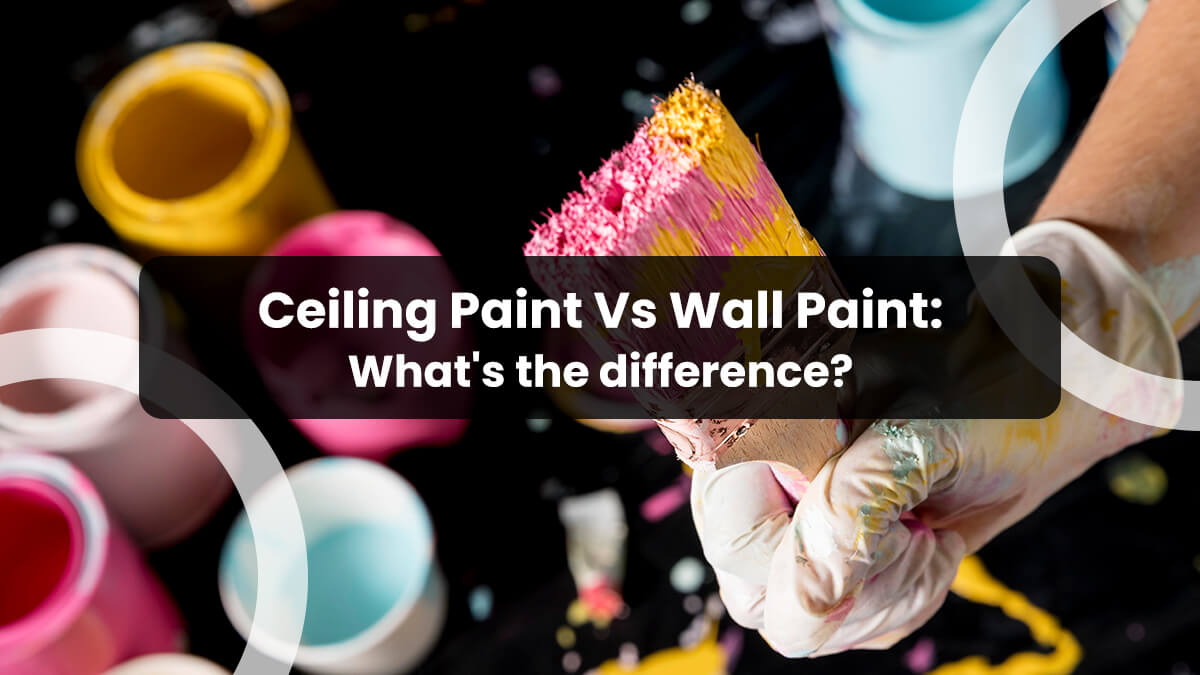Ceiling Colour Vs Wall Colour: What’s the difference?
Which colour do you prefer when it comes to the ceiling colour vs wall colour? The answer depends on who you ask. Some say they are pretty much the same, others claim they are totally different.
There are two types of interior paint colours – ceiling and wall paints. Both are applied using aerosol cans and are usually very similar in terms of application. They are available in a variety of shades and colour combinations. The Asian Paints Royale book of colours has introduced many such combinations for the ones that couldn’t be biased between the ceiling colour vs wall colour.
Ceiling colours tend to be brighter and lighter whereas wall colours are deeper and richer. This is because the light from above has a greater influence on the colour cast. If the room is bright enough, you might even see a difference in colour between the floor and walls.
Ceiling paint – Type of paint that is used on ceilings
Ceiling paint isn’t regular interior paint. Although you can paint your ceiling with the same paint that you used for your walls, regular wall paint is thin and has low viscosity, which means it will likely drip when you try to paint a ceiling. Ceiling paints, on the other hand, are thicker and designed to better grip the ceiling for fewer drips and unsightly runs that are difficult to fix after drying. Plus, certain ceiling paint types better hide stains, spots and small defects, providing your ceiling with a clean, uniform finish.
Naturally, paints specified as ceiling paints are the safest option for painting your ceiling. Ceiling paints are durable, low-sheen and require little to no maintenance. If you have a textured ceiling, however, ceiling paint may be difficult to spread and so thick that it dulls the texture’s appearance. In such exceptional cases, the texture paints enter the picture over these two.
Wall paint – Type of paint that is used on walls
Wall paints are formulated to be more durable and easier for you to clean the walls with water and soap on a regular basis. Cleaning and scrubbing do not damage the paint. They are also available in glossy finishes to create a spacious feel in your apartment or room.
The results that you achieve with wall paint depend on the characteristics of the paint. For example, you can use a combination of high-gloss and matt to create texture paints. Latex, matt paint, is velvety smooth and opaque. It hides imperfections and gives the walls a rich colour. The downside is that it’s hard to clean. You’d want to use this paint in low-traffic areas such as the primary bedroom.
Eggshell is the standard finish for wall paint. Flat and eggshell are similar, but eggshell has a hint of reflection. The colour tends to be flat, and it won’t adhere to semi-gloss paint. But they also frequently come in satin or pearl finishes. These finishes give off the sheen of a cleanable surface, making it simpler to remove handprints or marks than with flat surfaces.
Ceiling paint is usually a more expensive type of paint.
There has been much argument over the requirement of capitalising on ceiling paint rather than less expensive wall paint when painting the ceiling. In composition, both colours are similar, and ceiling paints feature additives that make painting much easier at the vertical angle. Because ceiling paint on walls has a softer binder and extender pigment than wall paint does, it won’t hold up to thorough scrubbing and cleaning in the same way. Therefore, ceiling paints are a good option, as these paints can cover all the edges and hide all imperfections. Also, these products are denser to allow for better quality.
One reason why you may consider an alternative is because ceiling paint is limited as far as colour goes. White and shades of white, are what you’ll get with this product. The thing is that some shade of white is typically the standard for ceilings. And there are ways to achieve a coloured ceiling if that’s what you want. You can have the store mix a custom colour. Many such combinations are given in the Asian Paints Royale book of colours to relieve you from the mediocre ceiling colours. Online wall paints are better options in this case than the local paint store mixes. Better you choose wisely.
Wall paint is usually a cheaper type of paint.
If you choose water-based paint, make sure to clean the walls first. Then, you can rough the surface up a bit with some fine sandpaper. Creating some texture will help the paint adhere to the surface, especially if the prior paint was oil-based. Some of the advantages of using water-based paint include less toxicity, which also means it doesn’t smell overwhelming. It also dries quickly, and you can easily clean it up with water.
Oil-based paint is more challenging to work with, and you should also wear protective gear if you choose this type. You’ll need to use a solvent, such as turpentine to clean brushes and everything else. The fumes are strong, so make sure the area is well-ventilated.
Which Is Better – Ceiling Colour Vs Wall Colour?
For now, I’m leaning towards ceiling paint. Here are two reasons why:
- Ceiling colour is preferable in ceiling colour Vs wall colour as they last longer and look better than wall paints. That being said, it’ll take less time to finish painting the whole ceiling compared to the entire wall. But if you decide to go with wall paints, you might have to spend a few extra days working on them.
- Because the walls are made of brick, I’m worried about damage to the paint. Brick is porous, which means that it absorbs moisture. If your wall gets wet, you could potentially cause mould growth inside the bricks.
Planning to buy online wall paints? Keep the above discussion in mind and choose wisely. We, here at Paintkart have some experts to help you with your decision. Connect with us for your queries.
One thing that is noticed is that certain brands of wall paints dry faster than others. Those brands tend to give off fumes while drying. These fumes might irritate your nose so it’s better to steer clear of those brands. I hope this helped!


